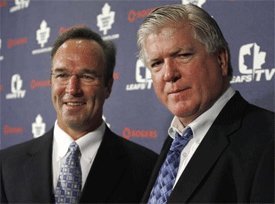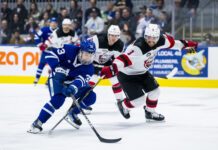
Prior to speaking with Rick Dudley for the Maple Leafs Annual, I also had the opportunity to speak with Dave Poulin, Vice-President of Hockey Operations for the Toronto Maple Leafs. Having contributed an interview for last year’s edition of the Annual, Mr. Poulin graciously agreed to accommodate our request again this year.
Follow the jump for a few excerpts of our chat.
As was the case with prior excerpts, the following quotes are excerpted from a larger interview and thus the flow of the questions may seem a bit off. The full interview will appear in the Maple Leafs Annual, due to hit newsstands in September.
GB: Looking at the goaltending as constructed at this time last year, James Reimer wasn’t a player who many thought of as a long-term solution. I suppose he’s proof that any player can be looked at as a long-term piece of the puzzle, regardless of their place on the depth chart.
DP: You have to look at every player long-term. If we look at last year, through the course of the year, the pieces we were able to add through through the draft, through trades, through free agent signings, we ‘re a much deeper, much better organization. Now, that has to translate into success on the ice short term as well, but I think from a positional standpoint the depth we’ve created and the prospect list we’ve created, and the team we’ve created are all better than they were a year ago at this time.
GB: And it’s not just depth in general that we’re talking about here, but young, highly-regarded depth.
DP: No question. You know, it’s interesting. If you look at the draft of 2008, if you were to leave that draft with the number five, number sixteen and number seventeen picks in Luke Schenn, Joe Colborne and Jake Gardiner, you’d have been ecstatic that day. Three different types of players, a stay-at-home defenseman, a big, skilled centreman, and an offensive defenseman who one of the best skaters that draft.
And now it’s three years later and you’ve seen their development: Jake had a wonderful three years at Wisconsin, Joe had two really good years at Denver and now a full year of development in the AHL, and obviously Luke has been an integral part of our team for three seasons. And those are the types of things you look at in terms of the depth of our organization now as compared to a year ago.
GB: What is about James Reimer that allowed him to handle that pressure so well and find the kind of success he did?
DP: What stands out more than anything else is his mentality, his demeanor. There’s a calmness to him that translates very well to the rest of the team.
GB: What are your expectations for Jonas Gustavsson this season?
DP: I’m expecting a big year from Jonas. He’s been here all summer and has worked out a different level than he ever has in his life. Physically he’s stronger, physically he’s better and that will contribute to a mental strength. Sometimes it takes a couple of years, sometimes a player has to put a couple of summers together to become successful at this level. And Jonas could certainly fall into that category.
GB: One player who struggled noticeably early, but seemed to find his game during the stretch was Tyler Bozak. Can you comment on the peaks and valleys he endured this past season?
DP: Sometimes it takes a while to determine exactly what a player is. He was cast in a role that perhaps wasn’t fair to him, being asked to be a first-line centre when he was still learning to play in the NHL.
When I first came into the NHL, I was a first-line centre. Which meant, flat-out, we weren’t good enough to win. What I mean by that is when we were playing another team and the centres on their top two lines wore numbers 99 and 11, and I was lining up against them, we weren’t good enough to win. But at the time in Philadelphia, we just didn’t have that player so I was asked to play that role and did, but wasn’t properly cast. And I think that’s fair to say for Tyler. Two or three years down the road, he may become that player. But last year he wasn’t, and that’s a pretty big load of pressure to put on a young guy.
GB: There was a noticeable spark in the team’s play after the string of trades last February. When a number of players – especially a number of veteran players – are traded in a short period of time, and the dynamics of a team change so quickly, does that result in a sort of rallying effect among those who remain?
DP: You know, the smartest people in every sport have tried to create perfect lineups on paper, and while the dynamic of what happens in the locker room is a variable that you can certainly try to control — you don’t control that. You can put all the right personalities in place, but they have to mesh, and they still need to have the right leadership and the right support for that leadership. Some of the most unique teams that I played on were not the best teams on paper. So you don’t really know how the personality aspect will play out until you put them in that locker room, and our locker room clicked very, very well down the stretch.
GB: Many of the team’s offseason moves could be considered under the radar in the context of media speculation and the oft-stated desire of the fanbase for a big splash. Can the “under the radar” or “understated” moves create the same impact as those of the “big splash” variety?
DP: I think a lot of the things we’ve done this year were a little bit under the radar from our standpoint as none were the big splash that everyone demands these days. But at the end of the day our focus is on building a good hockey team and a good hockey organization. You might look back and say that Matt Frattin was an understated 4th round draft pick, and now the patience letting him develop is paying off as it looks like he might be a pretty good hockey player. James Reimer was also a pretty understated draft pick a few years ago. So yes, an acquisition that may seem understated at the time can have a tremendous impact in the long run.
GB: Would it be fair to equate the focus on building depth with the pursuit of long-term sustainability?
DP: Absolutely. And you can never have too much depth at any position. The players will dictate their minutes, and their roles. Competition is extremely healthy.
GB: How difficult is it to be patient with prospects when the NHL team is struggling?
DP: The difficulty in building a team is, you can be patient with your youth when you’re better up top. It’s hard to be patient with your prospects when your team has holes to fill. But you when look at the development some of the prospects in our organization, there is a lot to be excited about.
Jessie Blacker is going to be a really good hockey player, as is Jake Gardiner. The growth of Nazem Kadri, Joe Colborne and Matt Frattin. Greg McKegg scored 49 goals in the OHL last year. Josh Nicholls had a monster year in the WHL. And those are just a couple of examples. You look further and see players such as Brad Ross, Andrew MacWilliam, Daniel Brodin and Sondre Olden, among several others. This year’s first round picks, Tyler Biggs and Stuart Percy. All players who will push to get to that next level, and push the players ahead of them. And we are very excited about that.
GB: When you look at the Toronto Maple Leafs, top to bottom, what excites you most?
DP: The direction we’re going in is extremely positive. If you divide the organization into three pieces, you have the Toronto Maple Leafs, the Toronto Marlies, and the Leafs/Marlies prospects: the group that is still in college, Junior or Europe. The most exciting part of it, to me, is the potential of the second and third group to be members of the first group. And it is that groundswell of talented youth pushing upward that should have fans enthused about the future of the organization.


































